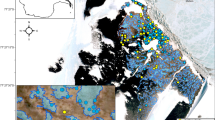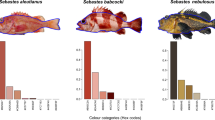Abstract
By analysing the deuterium concentration in the scapulars and rectrices (δ2Hf) of breeding and spring migrating Ortolan Buntings (Emberiza hortulana), we found a high correlation attesting that spring body and central rectrices have grown in similar isotopic environments. Furthermore, we failed to find a correlation between δ2Hf of the rectrices and the amount-weighted growing season precipitation δ2Hp of sites where we captured the birds. Winter-grown body coverts and rectrices displayed similar probabilistic assignments to origin. Further examination of 76 tails of breeding birds captured in Finland in May–June confirmed that breeding birds wear recently moulted central rectrices. The body coverts are known to moult during the winter partial moult in that species, but the rectrices have been reported to moult only once a year, during the complete post-breeding moult occurring on the breeding grounds in summer. Here, we reveal the common replacement of the central pair in winter, as well. The winter tail moult could occur beyond the central pair in some individuals, but this has still to be confirmed or refuted, by, e.g., further isotopic investigations.
Zusammenfassung
Stabile Isotope belegen eine verbreitete Wintermauser der mittleren Steuerfedern bei einem langstreckenziehenden Singvogel
Bei der Analyse der Deuteriumkonzentration (δ2Hf) in den Schulter- und Steuerfedern von Ortolanen Emberiza hortulana zur Brutzeit und auf dem Frühjahrszug fanden wir eine starke Korrelation, welche belegt, dass die im Frühling getragenen Körper- und mittleren Steuerfedern in isotopisch ähnlicher Umgebung gewachsen waren. Des Weiteren fanden wir keine Korrelation zwischen dem δ2Hf-Wert der Steuerfedern und dem nach Menge gewichteten δ2Hp-Wert des Niederschlags während der Wachstumsperiode an den Orten, an denen die Vögel gefangen wurden. Die im Winter vermauserten Körperdecken und Steuerfedern zeigten ähnliche Zuordnungen zu wahrscheinlichen Herkunftsgebieten. Die weitere Untersuchung von 76 Steuern von zwischen Mai-Juni in Finnland gefangenen Brutvögeln bestätigte, dass Brutvögel frisch vermauserte mittlere Steuerfedern trugen. Es ist bekannt, dass diese Vogelart das Körperdeckgefieder während der Winterteilmauser erneuert, allerdings hieß es, dass die Steuerfedern nur einmal jährlich, während der Sommerkomplettmauser im Brutgebiet, gemausert würden. Wir belegen hier, dass das mittlere Paar häufig auch im Winter vermausert wird. Bei manchen Individuen könnte die Steuerfedermauser außer dem mittleren auch weitere Federpaare umfassen; dies muss aber noch z. B. durch weitere Isotopenstudien bestätigt oder widerlegt werden.





Similar content being viewed by others
References
Barta Z, Houston AI, McNamara JM, Welham RK, Hedenström A, Weber TP, Feró O (2006) Annual routines of non-migratory birds: optimal moult strategies. Oikos 112:580–593
Barta Z, McNamara JM, Houston AI, Weber TP, Hedenström A, Feró O (2008) Optimal moult strategies in migratory birds. Philos Trans R Soc Lond B 363:211–229
Beltran RS, Burns JM, Breed GA (2018) Convergence of biannual moulting strategies across birds and mammals. Proc R Soc Lond B 285:20180318. https://doi.org/10.1098/rspb.2018.0318
BirdLife International, NatureServe (2018) Version 1.0. BirdLife International, Cambridge, UK and NatureServe, Arlington, USA
Bollen KA, Jackman RW (1990) Regression diagnostics: an expository treatment of outliers and influential cases. In: Fox J, Long JS (eds) Modern methods of data analysis. Sage, Newbury Park, pp 257–291
Bowen GJ, Wassenaar LI, Hobson KA (2005) Global application of stable hydrogen and oxygen isotopes to wildlife forensics. Oecologia 143:337–348
Bridge ES (2008) How does imping affect wing performance? J Wildl Rehabil 29:4–9
Cook RD (1977) Detection of influential observations in linear regression. Technometrics 19:15–18
Cramp S, Perrins CM (1994) Ortolan Bunting Emberiza hortulana. Handbook of the birds of Europe, the Middle East end North Africa—the birds of the Western Paleartic—volume IX—buntings and new world warblers. Oxford University Press, Oxford, pp 209–223
Dale S (2001) Female-biased dispersal, low female recruitment, unpaired males, and the extinction of small and isolated bird populations. Oikos 92:344–356
Dale S (2016) Cost of reproduction: a comparison of survival rates of breeding and non-breeding male Ortolan Buntings. J Avian Biol 47:583–588
Danner RM, Greenberg RS, Danner JE, Walters JR (2015) Winter food limits timing of pre-alternate moult in a short-distance migratory bird. Funct Ecol 29:259–267
Demongin L (2013) Guide d’identification des oiseaux en main. Baume-les-Dames, France
Gutiérrez-Expósito C, Ramírez F, Afán I, Forero MG, Hobson KA (2015) Toward a Deuterium feather isoscape for sub-saharan Africa: progress, challenges and the path ahead. PLoS One 10(9):e0135938. https://doi.org/10.1371/journal.pone.0135938
Hedenström A, Bensch S, Hasselquist D, Lindström Å, Åkesson S, Pearson DJ (1992) Split moult: stress or strategy? Ringing Migr 13:179–180
Hobson KA, Wassenaar LI (2018) Tracking animal migration using stable isotopes, 2nd edn. Academic, London
Hobson KA, Van Wilgenburg SL, Wassenaar LI, Larson K (2012) Linking hydrogen (δ 2H) isotopes in feathers and precipitation: sources of variance and consequences for assignment to isoscapes. PLoS ONE 7(4):e35137
Holmgren N, Hedenström A (1995) The scheduling of molt in migratory birds. J Evol Ecol 9:354–368
Inger R, Bearhop S (2008) Applications of stable isotope analyses to avian ecology. Ibis 150:447–461
Jenni L, Winkler R (1994) Moult and ageing of European passerines. A&C Black, London. ISBN 0-12-384150-X
Jiguet F, Robert A, Lorrillière R, Hobson KA, Kardynal KJ, Arlettaz R, Bairlein F, Belik V, Bernardy P, Copete JL, Czajkowski MA, Dale S, Dombrovski V, Ducros D, Efrat R, Elts J, Ferrand Y, Marja R, Minkevicius S, Olsson P, Pérez M, Piha M, Raković M, Schmaljohann H, Seimola T, Selstam G, Siblet J-P, Skierczyǹski M, Sokolov A, Sondell J, Moussy C (2019) Unravelling migration connectivity reveals unsustainable hunting of the declining ortolan bunting. Sci Adv 5:eaau2642
Kiat Y, Izhaki I, Sapir N (2018) The effects of long-distance migration on the evolution of moult strategies in Western-Palearctic passerines. Biol Rev Camb Philos Soc. https://doi.org/10.1111/brv.12474
Lindström Å, Pearson DJ, Hasselquist D, Hedenström A, Bensch S, Akesson S (1993) The moult of Barred Warblers Sylvia nisoria in Kenya—evidence for a split wing-moult pattern initiated during the birds’ first winter. Ibis 135:403–409
Marquiss M, Newton I, Hobson KA, Kolbeinsson Y (2012) Origins of irruptive migrations by Common Crossbills Loxia curvirostra into northwestern Europe revealed by stable isotope analysis. Ibis 154:400–409
Merilä J, Hemborg C (2000) Fitness and feather wear in the collared flycatcher Ficedula albicollis. J Avian Biol 31:504–510
Moussy C, Arlettaz R, Copete JL, Dale S, Dombrovski V, Elts J, Lorrillière R, Marja R, Pasquet E, Piha M, Rakovic M, Seimola T, Selstam G, Jiguet F (2018) The genetic structure of the European breeding populations of a declining farmland bird, the ortolan bunting (Emberiza hortulana), reveals conservation priorities. Conserv Genet 19:909–922
Neto JM, Newton J, Gosler AG, Perrins CM (2006) Using stable isotope analysis to determine the winter moult extent in migratory birds: the complex moult of Savi’s warblers Locustella luscinioides. J Avian Biol 37:117–124
Nikolaus G, Pearson D (1991) The seasonal separation of primary and secondary moult in Palaearctic passerine migrants on the Sudan coast. Ringing Migr 12:46–47
Procházka P, Van Wilgenburg SL, Neto JM, Yosef R, Hobson KA (2013) Using stable hydrogen isotopes (δ 2H) and ring recoveries to trace natal origins in a Eurasian passerine with a migratory divide. J Avian Biol 44:541–550
Royle JA, Rubenstein DR (2004) The role of species abundance in determining breeding origins of migratory birds with stable isotopes. Ecol Appl 14:1780–1788
Svensson L (1992) Identification guide to european passerines, 4th edn. British Trust for Ornithology, Stockholm
Underhill L, Prys-Jones RP, Dowsett R, Herroelen P, Johnson DN, Lawn MR, Norman SC, Pearson DJ, Tree A (1992) The biannual primary moult of Willow Warblers Phylloscopus trochilus.Europe and Africa. Ibis 134:286–297
Van der Meer T, te Grotenhuis M, Pelzer B (2010) Influential cases in multilevel modeling. A methodological comment. Am Sociol Rev 75:173–178
Wassenaar LI, Hobson KA (2003) Comparative equilibration and online technique for determination of non-exchangeable hydrogen of keratins for use in animal migration studies, Isotopes in Environ Health Stud 39:211–217
Ackowledgements
We are grateful to all our colleagues who helped in the field work, monitoring and capturing of the buntings. We thank two anonymous reviewers who provided important insights to clarify the moult patterns of buntings. This research was funded by Conseil Général des Landes, Région Aquitaine, Région Nouvelle Aquitaine, Fédération Départementale des Chasseurs des Landes (FDC40), Association Départementale des Chasses Traditionnelles à la Matole (ADCTM), French Ministry in charge of the Environment. Environment and Climate Change Canada supported the stable isotope analyses through an operating grant to Keith Hobson. The Polish National Science Centre (NCN) partially promoted the research in Poland—MS was funded by Grant no. N N304 0198 40.
Author information
Authors and Affiliations
Corresponding author
Additional information
Communicated by N. Chernetsov.
Publisher's Note
Springer Nature remains neutral with regard to jurisdictional claims in published maps and institutional affiliations.
Electronic supplementary material
Below is the link to the electronic supplementary material.
Rights and permissions
About this article
Cite this article
Jiguet, F., Kardynal, K.J., Piha, M. et al. Stable isotopes reveal the common winter moult of central rectrices in a long-distance migrant songbird. J Ornithol 160, 1077–1085 (2019). https://doi.org/10.1007/s10336-019-01671-w
Received:
Revised:
Accepted:
Published:
Issue Date:
DOI: https://doi.org/10.1007/s10336-019-01671-w




